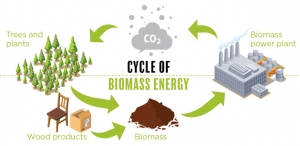Environmental pollution: Biomass burning; meaning, causes and effects on humans and the environment.

One of the main damages to our Environment and wildlife conservation is Atmospheric pollution arising from fossil fuel, it has horrific and bad consequence on health, the plants, the animals and the planet. Alternatively, biomass burning is harmful on living organisms but is great one the great remedy to earth environmental problems.
Biomass Burning;
This is another way (of polluting the atmosphere) by which man unknowingly contributes to emission of greenhouse gases and consequently impart negatively on health. Biomass burning is the burning of living and dead vegetation. It includes the human initiated burning of vegetation for land clearing and land use as well as natural, lighting-induced fire. Scientists’ estimate that human are responsible for about 90% of biomass burning with only a small percentage of natural fire contributing to the total amount of vegetation burned [WMO, 1991].
Biomass burning can equally be viewed as emission of combustion products that include greenhouse gases into the atmosphere and the loss of biomass useful valuable material resource. The extent of biomass burning generally in Africa and particularly in Nigeria coupled with the complexity of the reaction involved: alongside its health implications constitute an important motivation to view it as a global problem deserving priority attention and careful multisided investigation because air vegetation is not boundary i.e., it is transboundary.
Burning vegetation releases large amount of particulates (solid carbon combustion particles) and gases, including greenhouse gases that helps warm the earth. Greenhouse gases may lead to an increased warming of the earth or human-initiated global climate change. Studies suggest that biomass burning as increased on a global scale over the last 100 years, and computer calculation indicates that a hotter earth resulting from global warming will lead to more frequent and larger fires. Biomass burning particulates impact climate and can also affect human health when they are inhaled, causing respiratory problems [Menzel et al., 1991]
Since fires produce CO2, a major greenhouse gas, biomass burning emissions significantly influence the earth’s atmosphere and climate. Biomass burning as both short-and-long-term impact on the environment. Vegetation acts as a sink, a natural storage area for carbon dioxide by storing it over time through the process of photosynthesis. As burning occurs, it can release hundreds of years’ worth of stored carbon dioxide into the atmosphere in a matter of hours. Burning also will permanently destroy an important sink for carbo dioxide if the vegetation is not replaced. It is hypothesised that enhanced post-burn biogenic emission of these gases are related to fire-induced changes in soil chemistry and/or microbial ecology. Biomass burning, once believed to be a tropical phenomenon, has been demonstrated by satellite imagery to also be a regular feature of the world’s boreal forests. One example of biomass burning is the extensive 1987 fire that destroyed more than 12 million acres of boreal forest in the People’s Republic of china and across its border in the Soviet Union [Cahoon et al., 1991].
Recent estimates indicate that all biomass burning is human-initiated and that it is increasing with time. With the formation of greenhouse and chemically active gases as direct combustion products and a longer-term enhancement of biogenic emissions of gases, biomass burning may be a significant driver for global change [Cahoon et al., 1991].
The historic data indicate that biomass burning has increased with time and that the production of greenhouse gases from biomass burning has increased with time. Furthermore, the bulk of biomass burning is human initiated. As greenhouse gases build up in the atmosphere and the Earth becomes warmer, there may be an enhanced frequency of fires. The enhanced frequency of fires may prove to be an important positive feedback on a warming Earth. However, the bulk of biomass burning worldwide may be significantly reduced. Policy options for mitigating biomass burning have been developed (Andrask et al., 1991).
For mitigation biomass burning in the tropical forests, where the burning is aimed at land clearing and conversion to agricultural lands, policy options include the marketing of timber as a resource and improved productivity of existing agricultural lands to reduce the need for conversion of forests to agricultural lands. Improved productivity will result from the application of new agricultural technology (fertilizers, etc.). For mitigation burning in tropical savannas grasslands, animal grazing could be replaced by stall feeding since savannas burning results from the need to replace nutrient-poor tall grass with nutrient-rich short grass. For mitigating burning of agricultural lands and croplands, incorporate crop wastes into the soil, instead of burning, as is the present practice throughout the world. The crop waste could also be used as fuel for household heating and cooking rather than cutting down and destroying forests for fuel as is presently done.
Great writing. Keep it up.
Thanks for the support!